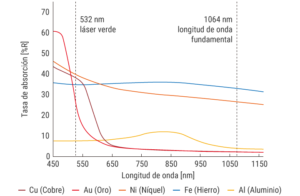Metal laser making (2) – Elena
This section presents information that ranges from the principles of metal marking and processing to the advantages, grouped by the laser wavelength.
It presents examples of marking and optimal laser markers for a variety of materials such as aluminum, stainless steel, iron, copper, cemented carbide and gold plating.
Metal Absorption Rate
The following graph shows the different absorption rates of metallic materials with a green laser (532 nm) and a standard wavelength (1064 nm). There is no significant change in the absorption rate of iron (Fe), nickel (Ni) or aluminum (Al) when the wavelength is changed. However, the rate of absorption of gold (Au) and copper (Cu) is greatly affected by changes in wavelength. The absorption rate for gold (Au) with wavelengths of 532 nm is approximately 30%. But with the standard wavelength of 1064 nm the absorption rate is less than 10%. Similarly, with a wavelength of 532 nm, copper (Cu) has an absorption rate of 40%, while that rate is less than 10% with the standard wavelength of 1064 nm.

Aluminum
Annealed black marking
On aluminum surfaces, the black annealing marking appears as a very visible dark gray. The heat is applied to the metal surface with a laser to generate an oxide film. So it can makes the dark gray.
Selection factor
Aluminum has a higher reflectance than iron or stainless steel, so select a laser with a high peak power. For aluminum materials, laser markers with the standard wavelength (1064 nm) are optimal. Keep the spot diameter of the small beam and mark with a high energy density, keeping the laser beam focused to achieve a beautifully colored mark.
White marking
White marking is achieved by slightly etching the surface of the material.
The roughing of the metal surface causes a diffuse reflection of the light, resulting in a white marking.
Selection factor
Increasing power and setting a faster sweep speed allows users to stably mark targets, and under a wide range of conditions. As with the black marking, the laser markers with the standard wavelength are optimal.
Deep engraving
This method allows users to record and mark without coloring, similar to stamping. Deeper engravings are possible by multiple markings. Deep engraving offers several advantages, such as ensuring visibility, even after applying paint at the end of marking.
Selection factor
For engraving, a fiber laser with a long pulse duration is better to melt and vaporize the marked surface. In some cases, dialing several times in the same place quickly will provide a clearer marking, than dial slowly. Marking at a lower frequency and with higher pulse energy makes engraving easier.
more information please click:www.xtlaser.com



